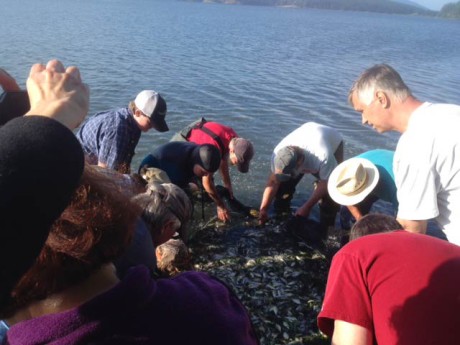Mud Bay Event Attracts People and Fish
Posted June 4, 2015 at 5:45 am by Tim Dustrude

A recent event hosted by FRIENDS of the San Juans and fisherman Randy O’Bryant showed many shoreline species are currently active off of Lopez Island. On May 17, over 20 community members of all ages joined the event to learn about marine species that make Mud and Hunter Bays one of the biological hot spots in the San Juans.
Participants found hundreds of incubating surf smelt eggs in the sand at the high tide, and a beach seine yielded many juvenile and adult surf smelt, and a host of other shallow-water species common to our area including: pacific herring; striped, shiner and pile perch; bay pipefish; staghorn sculpin; snake prickleback; starry flounder; greenling; three-spined stickleback and multiple species of gunnel, juvenile flatfish, crabs and the “eelgrass sea slug” Phyllaplysia taylori.
“It was great to gather with neighbors, see the fish that are in our backyard, and learn how to be better stewards for this special place,” said Gary Bergren, Lopez Resident.
Thank you to Ron Mayo for allowing access to his beach for this informational and fun event. For more information on shoreline habitat, forage fish or technical assistance on how you can help protect or restore shoreline habitat in the San Juans, please contact Tina Whitman, Science Director at FRIENDS of the San Juans at 360-378-2319 or visit our website at www.sanjuans.org.
You can support the San Juan Update by doing business with our loyal advertisers, and by making a one-time contribution or a recurring donation.
Categories: Around Here










No comments yet. Be the first!
By submitting a comment you grant the San Juan Update a perpetual license to reproduce your words and name/web site in attribution. Inappropriate, irrelevant and contentious comments may not be published at an admin's discretion. Your email is used for verification purposes only, it will never be shared.